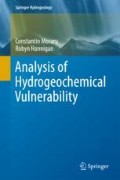Abstract
Hydrogeochemical vulnerability is a part of groundwater vulnerability study. At present time, different meaning of pollutant, unsaturated zone, and aquifer is proposed in scientific literature. The analysis of these basic terms has been done. Contamination, pollution, and pollutants are differentiated. Unsaturated zone or vadose zone notion is analyzed related to the groundwater vulnerability. The modern meaning of an aquifer is described from the view of water quality protection.
Access this chapter
Tax calculation will be finalised at checkout
Purchases are for personal use only
References
Alitovskii, M. E. (1962). Spravocnik gidrogeologa (p. 586). Moskva: Nedra.
Appelo, C. A. J. & Postma, D. (1993). In A. A. Balkema (ed.) Geochemistry, ground water and pollution (p. 536). Rotterdam.
Aquachem V. 4.0. (2003). User’s Manual. Lukas Calmbach and Waterloo Hydrogeologic, Inc, p. 276.
Berkovwitz, B., Dror, I., Yaron, B. (2008). Contaminant geochemistry, interaction and transport in the subsurface environment (p. 412). New York: Springer.
Committee on Techniques for assessing ground water vulnerability (USA). (1993). Ground water vulnerability assessment: contamination potential under conditions of uncertainty (p. 204). Washington: National Academic Press.
COST action 620: Vulnerability and risk mapping for the protection of the carbonate (karst) aquifer. Final report, 2003. (edited by Francois Zwahlen), European Commission, Directorate—General for Research: 297p.
Driver, J. I. (1988). The geochemistry of natural water (p. 436). Upper Saddle River: Prentice Hall Inc.
Faure, G. (1998). Principles and applications of geochemistry (p. 600). Upper Saddle River: Prentice Hall.
Fetter, C. W. (2001). Applied hydrogeology (4th edn., p. 598). Upper Saddle River: Prentice-Hall.
Freeze, R. A., Cherry, J. A. (1979). Groundwater (p. 604). Upper Saddle River: Prentice Hall.
Goldberg, V. M., & Gazda, S. (1984). Gidrogeologicheskie osnovy okhrany podzemnykh vod ot zagryazneniya [Hydrogeological principles of groundwater protection against pollution] (p. 238). Moscow: Nedra.
Goldberg, V. M. (1987). Vzaimosveazi zagreaznenia podzemnyh vod i prirodnoi sredy (p. 248). Moscow: Gidrometeoizdat.
Gurdak, J. J. (2008). Ground-water vulnerability: Nonpoint-source contamination, climate variability, and the High Plains aquifer (p. 223). Saarbrucken, Germany: VDM Verlag Publishing, ISBN: 978-3-639-09427-5.
Heath, R. C. (1987). Basic ground-water hydrology (p. 84). USGS: US Government printing office.
Hudak, P. F. (2000). Principles of hydrogeology (p. 204). USA: Lewis Publishers.
Langmir, D. (1997). Aqueous environmental geochemistry (p. 601). Upper Saddle River: Prentice Hall Inc.
Merkel B. I., Planer–Friedrich B. (2008). Groundwater geochemistry: A practical guide to modeling of natural and contaminated aquatic systems, 2nd ed. (p. 230). Springer.
Moraru, C. E. (2009). Gidrogeohimia podzemnyh vod zony activnogo vodoobmena krainego Iugo-Zapada Vostocno – Evropeiskoi platformy (Vol. 1, p. 210). Chisinau: Elena.
Moraru, C. E. & Anderson, J. A. (2005). A Comparative Assessment of the Ground Water Quality of the Republic of Moldova and the Memphis, TN Area of the United States of America (p. 188). Ground Water Institute, Memphis, TN.
Moraru, C., & Zincenco, O. (2005). Podzemnye vody g. Kishinev (Vol. 1, p. 111). Chisinau: Elena.
Myrlean, N. F., Moraru, C. E. & Nastas, G. E. (1992). The Ecological and Geochemical Atlas of the City of Chisinau (p. 191). Chisinau: Stiinta (in Russian).
Perelman, A. I. (1982). Geohimia prirodnyh vod (p. 152). Moscow: Nauka.
Perelman, A. I. (1989). Geohimia (p. 528). Moscow: Vyshaia skola.
Polubarinova-Kocina, P. Ya. (1952). The theory of ground water movement (p. 380). Moscow: Nauka.
Samarina, V. S. (1977). Gidrogeohimia (p. 280). Leningrad: LGU.
Soliman, M. M., et al. (1997). Environmental hydrogeology (p. 386). Boca Raton: Lewis publishers.
Sources of pollution. (2014). http://www.euwfd.com/html/source_of_pollution_-_overview.html.
Shestakov, V. M., & Pozdneakov, S. P. (2003). Geogidrologia. Akademkniga, p. 176.
Tindal, J. A., Kunkel, J. R., & Anderson, D. E. (1999). Unsaturated zone hydrology for scientists and engineers (p. 624). United Saddle River: Prentice-Hall Inc.
Todd, D. K. (1980). Groundwater hydrology (p. 535). USA: Willey.
Wellings, S. R., & Bell, J. P. (1980). Movement of water and nitartes in the unsaturated zone of upper chalk near Winchester, Hants, England. Journal of Hydrology, 48, 119–136.
Wellings, S. R., & Bell, J. P. (1982). Pysical control of water movement in the unsaturated zone. The Quaternaly Journal of engineering geology, 15, 235–241.
Wight, W. D., & Sondereger, J. L. (2001). Manual of applied field hydrogeology (p. 608). New York: McGraw-Hill.
Author information
Authors and Affiliations
Corresponding author
Rights and permissions
Copyright information
© 2018 Springer International Publishing AG
About this chapter
Cite this chapter
Moraru, C., Hannigan, R. (2018). Basic Principles of Hydrogeology for Hydrogeochemical Vulnerability. In: Analysis of Hydrogeochemical Vulnerability. Springer Hydrogeology. Springer, Cham. https://doi.org/10.1007/978-3-319-70960-4_3
Download citation
DOI: https://doi.org/10.1007/978-3-319-70960-4_3
Published:
Publisher Name: Springer, Cham
Print ISBN: 978-3-319-70959-8
Online ISBN: 978-3-319-70960-4
eBook Packages: Earth and Environmental ScienceEarth and Environmental Science (R0)

